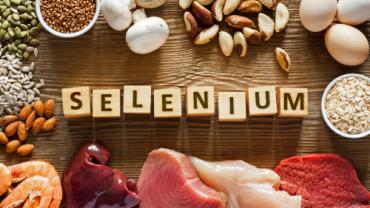
If Brazil nuts are the only things that come to mind when you think about selenium, no one could blame you. This nutrient doesn’t have celebratory odes being written to it in natural health publications like magnesium and vitamin D do. Few people sing the praises of selenium, so let’s give this trace mineral a turn in the spotlight.
Selenium is best known for its role in four glutathione peroxidase enzymes. These critical antioxidants are present in the blood, extracellular fluid, and inside cells—in other words, everywhere. Selenium is also a crucial element in thyroid hormone synthesis. The de-iodinase enzymes that convert thyroxine (T4) to triiodothyronine (T3) are selenoproteins, most active in the liver and kidneys. Owing to the varied processes influenced by glutathione peroxidase, adequate selenium appears to also be important for skin health and for preventing or reducing acne.
Selenium content of foods is difficult to estimate, because it’s largely dependent on the soil selenium content. Plants concentrate selenium, and the animals that consume those plants will only get as much selenium as they contain. Certain plants are considered “selenium accumulators,” in particular, garlic, the aforementioned Brazil nuts, and vegetables in the Brassica family. However, even a selenium accumulator can only accumulate as much selenium as there is to be accumulated. According to the Linus Pauling Institute Micronutrient Information Center at Oregon State University, “Brazil nuts grown in areas of Brazil with selenium-rich soil may provide more than 100 μg of selenium in one nut, while those grown in selenium-poor soil provide 10 times less.”
Most people in the developed world get enough selenium, but selenium turnover and loss are accelerated during times of increased oxidative stress. Strenuous exercise, smoking, chronic illness, and exposure to environmental toxins and heavy metals may increase need for selenium. Additionally, vegetarian diets may not provide adequate selenium. A small study from Slovakia found that compared to omnivores, those eating a vegetarian diet had significantly lower plasma and erythrocyte selenium concentrations and lower plasma and erythrocyte glutathione peroxidase activity. Whole grains and legumes provide selenium, but the most concentrated sources (aside from Brazil nuts) are animal foods, such as finfish and shellfish, beef, and pork. (Selenium may even be protective against the mercury in seafood, and even in the presence of moderate mercury, selenium bioavailability appears to be preserved.) Aside from those following exclusively plant-based diets, others at risk for selenium deficiency include post-bariatric surgery patients and those with malabsorptive GI disorders.
Although overt selenium deficiency is rare, signs to look out for include hair loss, infertility, growth retardation, and anemia. Vitamin E deficiency seems to exacerbate the effects of poor selenium status in animals. Severe deficiency may result in Kashin-Beck disease, a form of childhood osteoarthritis, or Keshan disease, which causes cardiomyopathy and other heart disease. Conversely, selenium toxicity may result in brittle nails or white spots on the nails, dermatitis, depression, and neurological abnormalities.
Owing to its role in thyroid hormone production, inadequate selenium status may contribute to hypothyroidism, but selenium should not be supplemented until iodine status is determined. Providing selenium in the context of iodine deficiency may actually exacerbate hypothyroidism.
There’s some evidence that selenium and selenium-containing compounds may have therapeutic effects in cancer, but findings are highly mixed and inconclusive. In fact, a 2018 Cochrane review found that selenium supplementation may increase risk for type 2 diabetes and prostate cancer. Some studies have reported selenium supplementation as being beneficial for decreasing some of the side effects of chemotherapy, but this is also inconclusive.
Overall, it seems whole food sources are the best way to get selenium, but certain individuals may benefit from supplementation, particularly if they experience signs and symptoms that may be related to suboptimal levels, or show reduced glutathione peroxidase activity.